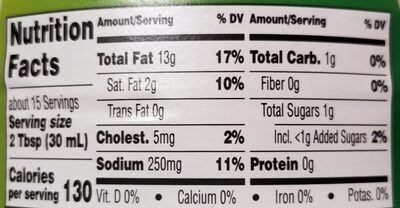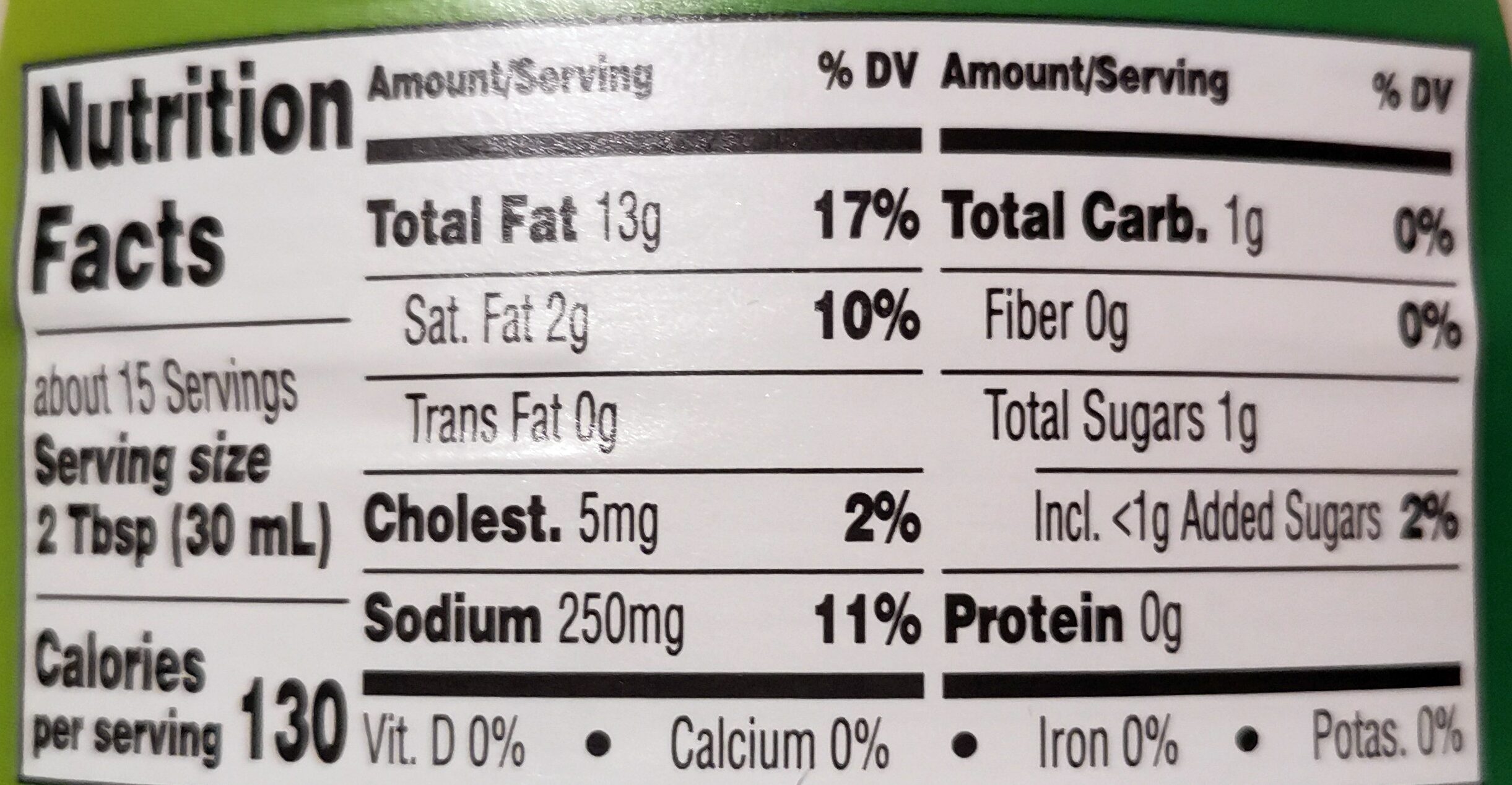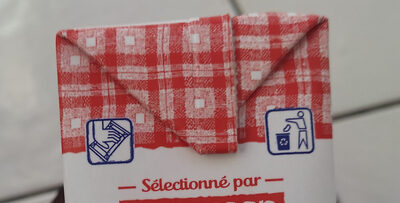Help us make food transparency the norm!
As a non-profit organization, we depend on your donations to continue informing consumers around the world about what they eat.
The food revolution starts with you!
Ranch Dressing - Wish-Bone - 15 fl oz (444 ml)
Ranch Dressing - Wish-Bone - 15 fl oz (444 ml)
This product page is not complete. You can help to complete it by editing it and adding more data from the photos we have, or by taking more photos using the app for Android or iPhone/iPad. Thank you!
×
Barcode: 0041321005756 (EAN / EAN-13) 041321005756 (UPC / UPC-A)
Common name: creamy dressing.
Quantity: 15 fl oz (444 ml)
Brands: Wish-Bone
Brand owner: Pinnacle Foods Group LLC
Categories: Condiments, Specific products, Products for specific diets, Products without gluten, Sauces, Salad dressings, Cream sauces
Labels, certifications, awards: No gluten, No HFCS
Origin of ingredients: United States
Manufacturing or processing places: Chicago, Illinois, Estados Unidos
Link to the product page on the official site of the producer: https://www.wish-bone.com/creamy-dressin...
Countries where sold: Bolivia, French Polynesia, United States
Matching with your preferences
Health
Ingredients
-
22 ingredients
SOYBEAN OIL, WATER, SUGAR, SALT 2%, DISTILLED VINEGAR, BUTTERMILK, EGG YOLKS, MODIFIED CORN STARCH, DRIED GARLIC, XANTHAN GUM, DISODIUM PHOSPHATE, MONOSODIUM GLUTAMATE, DRIED ONION, NATURAL FLAVOR, SPICE, DISODIUM INOSINATE, DISODIUM GUANYLATE, PAPRIKA EXTRACTIVES (COLOR), PHOSPHORIC ACID, SORBIC ACID, CALCIUM DISODIUM EDTA.Allergens: Eggs, Milk, Soybeans
Food processing
-
Ultra processed foods
Elements that indicate the product is in the 4 - Ultra processed food and drink products group:
- Additive: E415 - Xanthan gum
- Additive: E621 - Monosodium glutamate
- Additive: E627 - Disodium guanylate
- Additive: E631 - Disodium inosinate
- Ingredient: Colour
- Ingredient: Flavouring
Food products are classified into 4 groups according to their degree of processing:
- Unprocessed or minimally processed foods
- Processed culinary ingredients
- Processed foods
- Ultra processed foods
The determination of the group is based on the category of the product and on the ingredients it contains.
Additives
-
E200 - Sorbic acid
Sorbic acid: Sorbic acid, or 2‚4-hexadienoic acid, is a natural organic compound used as a food preservative. It has the chemical formula CH3-CH-4CO2H. It is a colourless solid that is slightly soluble in water and sublimes readily. It was first isolated from the unripe berries of the Sorbus aucuparia -rowan tree-, hence its name.Source: Wikipedia
-
E338 - Phosphoric acid
Phosphoric acid: Phosphoric acid -also known as orthophosphoric acid or phosphoricV acid- is a weak acid with the chemical formula H3PO4. Orthophosphoric acid refers to phosphoric acid, which is the IUPAC name for this compound. The prefix ortho- is used to distinguish the acid from related phosphoric acids, called polyphosphoric acids. Orthophosphoric acid is a non-toxic acid, which, when pure, is a solid at room temperature and pressure. The conjugate base of phosphoric acid is the dihydrogen phosphate ion, H2PO−4, which in turn has a conjugate base of hydrogen phosphate, HPO2−4, which has a conjugate base of phosphate, PO3−4. Phosphates are essential for life.The most common source of phosphoric acid is an 85% aqueous solution; such solutions are colourless, odourless, and non-volatile. The 85% solution is a syrupy liquid, but still pourable. Although phosphoric acid does not meet the strict definition of a strong acid, the 85% solution is acidic enough to be corrosive. Because of the high percentage of phosphoric acid in this reagent, at least some of the orthophosphoric acid is condensed into polyphosphoric acids; for the sake of labeling and simplicity, the 85% represents H3PO4 as if it were all in the ortho form. Dilute aqueous solutions of phosphoric acid exist in the ortho form.Source: Wikipedia
-
E339ii - Disodium phosphate
Sodium phosphates: Sodium phosphate is a generic term for a variety of salts of sodium -Na+- and phosphate -PO43−-. Phosphate also forms families or condensed anions including di-, tri-, tetra-, and polyphosphates. Most of these salts are known in both anhydrous -water-free- and hydrated forms. The hydrates are more common than the anhydrous forms.Source: Wikipedia
-
E415 - Xanthan gum
Xanthan gum (E415) is a natural polysaccharide derived from fermented sugars, often used in the food industry as a thickening and stabilizing agent.
This versatile food additive enhances texture and prevents ingredient separation in a wide range of products, including salad dressings, sauces, and gluten-free baked goods.
It is considered safe for consumption even at high intake amounts.
-
E621 - Monosodium glutamate
Monosodium glutamate: Monosodium glutamate -MSG, also known as sodium glutamate- is the sodium salt of glutamic acid, one of the most abundant naturally occurring non-essential amino acids. Glutamic acid is found naturally in tomatoes, grapes, cheese, mushrooms and other foods.MSG is used in the food industry as a flavor enhancer with an umami taste that intensifies the meaty, savory flavor of food, as naturally occurring glutamate does in foods such as stews and meat soups. It was first prepared in 1908 by Japanese biochemist Kikunae Ikeda, who was trying to isolate and duplicate the savory taste of kombu, an edible seaweed used as a base for many Japanese soups. MSG as a flavor enhancer balances, blends, and rounds the perception of other tastes.The U.S. Food and Drug Administration has given MSG its generally recognized as safe -GRAS- designation. A popular belief is that large doses of MSG can cause headaches and other feelings of discomfort, known as "Chinese restaurant syndrome," but double-blind tests fail to find evidence of such a reaction. The European Union classifies it as a food additive permitted in certain foods and subject to quantitative limits. MSG has the HS code 29224220 and the E number E621.Source: Wikipedia
-
E627 - Disodium guanylate
Disodium guanylate: Disodium guanylate, also known as sodium 5'-guanylate and disodium 5'-guanylate, is a natural sodium salt of the flavor enhancing nucleotide guanosine monophosphate -GMP-. Disodium guanylate is a food additive with the E number E627. It is commonly used in conjunction with glutamic acid. As it is a fairly expensive additive, it is not used independently of glutamic acid; if disodium guanylate is present in a list of ingredients but MSG does not appear to be, it is likely that glutamic acid is provided as part of another ingredient such as a processed soy protein complex. It is often added to foods in conjunction with disodium inosinate; the combination is known as disodium 5'-ribonucleotides. Disodium guanylate is produced from dried seaweed and is often added to instant noodles, potato chips and other snacks, savory rice, tinned vegetables, cured meats, and packaged soup.Source: Wikipedia
-
E631 - Disodium inosinate
Disodium inosinate: Disodium inosinate -E631- is the disodium salt of inosinic acid with the chemical formula C10H11N4Na2O8P. It is used as a food additive and often found in instant noodles, potato chips, and a variety of other snacks. Although it can be obtained from bacterial fermentation of sugars, it is often commercially prepared from animal sources.Source: Wikipedia
Ingredients analysis
-
Palm oil free
No ingredients containing palm oil detected
-
Non-vegan
Non-vegan ingredients: Buttermilk, Egg yolk
-
Vegetarian status unknown
Unrecognized ingredients: E339ii
-
Details of the analysis of the ingredients
en: SOYBEAN OIL, WATER, SUGAR, SALT 2%, DISTILLED VINEGAR, BUTTERMILK, EGG YOLKS, MODIFIED CORN STARCH, DRIED GARLIC, XANTHAN GUM, DISODIUM PHOSPHATE, MONOSODIUM GLUTAMATE, DRIED ONION, NATURAL FLAVOR, SPICE, DISODIUM INOSINATE, DISODIUM GUANYLATE, PAPRIKA (COLOR), PHOSPHORIC ACID, SORBIC ACID, CALCIUM DISODIUM EDTA- SOYBEAN OIL -> en:soya-oil - vegan: yes - vegetarian: yes - from_palm_oil: no - ciqual_food_code: 17420 - percent_min: 12.67 - percent_max: 94
- WATER -> en:water - vegan: yes - vegetarian: yes - ciqual_food_code: 18066 - percent_min: 2 - percent_max: 48
- SUGAR -> en:sugar - vegan: yes - vegetarian: yes - ciqual_proxy_food_code: 31016 - percent_min: 2 - percent_max: 3.33
- SALT -> en:salt - vegan: yes - vegetarian: yes - ciqual_food_code: 11058 - percent_min: 2 - percent: 2 - percent_max: 2
- DISTILLED VINEGAR -> en:distilled-vinegar - vegan: yes - vegetarian: yes - ciqual_food_code: 11018 - percent_min: 0 - percent_max: 2
- BUTTERMILK -> en:buttermilk - vegan: no - vegetarian: yes - ciqual_food_code: 19801 - percent_min: 0 - percent_max: 2
- EGG YOLKS -> en:egg-yolk - vegan: no - vegetarian: yes - ciqual_food_code: 22002 - percent_min: 0 - percent_max: 2
- MODIFIED CORN STARCH -> en:modified-corn-starch - vegan: yes - vegetarian: yes - ciqual_food_code: 9510 - percent_min: 0 - percent_max: 2
- DRIED GARLIC -> en:dried-garlic - vegan: yes - vegetarian: yes - ciqual_food_code: 11023 - percent_min: 0 - percent_max: 2
- XANTHAN GUM -> en:e415 - vegan: yes - vegetarian: yes - percent_min: 0 - percent_max: 2
- DISODIUM PHOSPHATE -> en:e339ii - percent_min: 0 - percent_max: 2
- MONOSODIUM GLUTAMATE -> en:e621 - vegan: yes - vegetarian: yes - percent_min: 0 - percent_max: 2
- DRIED ONION -> en:dehydrated-onion - vegan: yes - vegetarian: yes - ciqual_food_code: 20180 - percent_min: 0 - percent_max: 2
- NATURAL FLAVOR -> en:natural-flavouring - vegan: maybe - vegetarian: maybe - percent_min: 0 - percent_max: 2
- SPICE -> en:spice - vegan: yes - vegetarian: yes - percent_min: 0 - percent_max: 2
- DISODIUM INOSINATE -> en:e631 - vegan: maybe - vegetarian: maybe - percent_min: 0 - percent_max: 2
- DISODIUM GUANYLATE -> en:e627 - vegan: maybe - vegetarian: maybe - percent_min: 0 - percent_max: 2
- PAPRIKA -> en:paprika - vegan: yes - vegetarian: yes - ciqual_food_code: 11049 - percent_min: 0 - percent_max: 2
- COLOR -> en:colour - percent_min: 0 - percent_max: 2
- PHOSPHORIC ACID -> en:e338 - vegan: yes - vegetarian: yes - percent_min: 0 - percent_max: 2
- SORBIC ACID -> en:e200 - vegan: yes - vegetarian: yes - percent_min: 0 - percent_max: 2
- CALCIUM DISODIUM EDTA -> en:e385 - vegan: yes - vegetarian: yes - percent_min: 0 - percent_max: 2
Nutrition
-
Bad nutritional quality
⚠ ️Warning: the amount of fruits, vegetables and nuts is not specified on the label, it was estimated from the list of ingredients: 2This product is not considered a beverage for the calculation of the Nutri-Score.
Positive points: 0
- Proteins: 0 / 5 (value: 0, rounded value: 0)
- Fiber: 0 / 5 (value: 0, rounded value: 0)
- Fruits, vegetables, nuts, and colza/walnut/olive oils: 0 / 5 (value: 2, rounded value: 2)
Negative points: 20
- Energy: 5 / 10 (value: 1810, rounded value: 1810)
- Sugars: 0 / 10 (value: 3.33, rounded value: 3.33)
- Saturated fat: 6 / 10 (value: 6.67, rounded value: 6.7)
- Sodium: 9 / 10 (value: 833, rounded value: 833)
The points for proteins are not counted because the negative points are greater or equal to 11.
Nutritional score: (20 - 0)
Nutri-Score:
-
Nutrient levels
-
Fat in high quantity (43.3%)
What you need to know- A high consumption of fat, especially saturated fats, can raise cholesterol, which increases the risk of heart diseases.
Recommendation: Limit the consumption of fat and saturated fat- Choose products with lower fat and saturated fat content.
-
Saturated fat in high quantity (6.67%)
What you need to know- A high consumption of fat, especially saturated fats, can raise cholesterol, which increases the risk of heart diseases.
Recommendation: Limit the consumption of fat and saturated fat- Choose products with lower fat and saturated fat content.
-
Sugars in low quantity (3.33%)
What you need to know- A high consumption of sugar can cause weight gain and tooth decay. It also augments the risk of type 2 diabetes and cardio-vascular diseases.
Recommendation: Limit the consumption of sugar and sugary drinks- Sugary drinks (such as sodas, fruit beverages, and fruit juices and nectars) should be limited as much as possible (no more than 1 glass a day).
- Choose products with lower sugar content and reduce the consumption of products with added sugars.
-
Salt in high quantity (2.08%)
What you need to know- A high consumption of salt (or sodium) can cause raised blood pressure, which can increase the risk of heart disease and stroke.
- Many people who have high blood pressure do not know it, as there are often no symptoms.
- Most people consume too much salt (on average 9 to 12 grams per day), around twice the recommended maximum level of intake.
Recommendation: Limit the consumption of salt and salted food- Reduce the quantity of salt used when cooking, and don't salt again at the table.
- Limit the consumption of salty snacks and choose products with lower salt content.
-
-
Nutrition facts
Nutrition facts As sold
for 100 g / 100 mlAs sold
per serving (2 tbsp 30 ml)Compared to: Cream sauces Energy 1,810 kj
(433 kcal)544 kj
(130 kcal)+84% Fat 43.3 g 13 g +123% Saturated fat 6.67 g 2 g +33% Trans fat 0 g 0 g Cholesterol 16.7 mg 5 mg Carbohydrates 3.33 g 1 g -48% Sugars 3.33 g 1 g +5% Added sugars < 3.33 g < 1 g Fiber 0 g 0 g -100% Proteins 0 g 0 g -100% Salt 2.08 g 0.625 g +68% Vitamin D 0 µg 0 µg (0 % DV) Potassium 0 mg 0 mg (0 % DV) Calcium 0 mg 0 mg (0 % DV) Iron 0 mg 0 mg (0 % DV) Fruits‚ vegetables‚ nuts and rapeseed‚ walnut and olive oils (estimate from ingredients list analysis) 2 % 2 %
Environment
-
Eco-Score B - Low environmental impact
⚠ ️Select a country in order to include the full impact of transportation.The Eco-Score is an experimental score that summarizes the environmental impacts of food products.→ The Eco-Score was initially developped for France and it is being extended to other European countries. The Eco-Score formula is subject to change as it is regularly improved to make it more precise and better suited to each country.Life cycle analysis
-
Average impact of products of the same category: A (Score: 84/100)
Category: Cream sauce
Category: Cream sauce
- PEF environmental score: 0.25 (the lower the score, the lower the impact)
- including impact on climate change: 2.17 kg CO2 eq/kg of product
Stage Impact Agriculture
54.4 %Processing
25.1 %Packaging
7.9 %Transportation
6.2 %Distribution
3.7 %Consumption
2.6 %
Bonuses and maluses
-
Origins of ingredients with a medium impact
Bonus: +1
Environmental policy: +1
Transportation: 0
Origin of the product and/or its ingredients % of ingredients Impact United States 100 %Medium
-
Packaging with a medium impact
Malus: -12
Shape Material Recycling Impact 1 Bottle Plastic High 1 Bottle cap Plastic High 2 Label Plastic High
Eco-Score for this product
-
Impact for this product: B (Score: 73/100)
Product: Ranch Dressing - Wish-Bone - 15 fl oz (444 ml)
Life cycle analysis score: 84
Sum of bonuses and maluses: -11
Final score: 73/100
-
Carbon footprint
-
Equal to driving 1.1 km in a petrol car
217 g CO² per 100g of product
The carbon emission figure comes from ADEME's Agribalyse database, for the category: Cream sauce (Source: ADEME Agribalyse Database)
Stage Impact Agriculture
66.3 %Processing
13.7 %Packaging
8.2 %Transportation
9.2 %Distribution
1.8 %Consumption
0.8 %
Packaging
-
Packaging with a medium impact
-
Packaging parts
1 x Bottle (Plastic)
1 x Bottle cap (Plastic)
2 x Label (Plastic)
-
Packaging materials
Material % Packaging weight Packaging weight per 100 g of product Plastic
-
Transportation
-
Origins of ingredients
Origins of ingredients with a medium impact
Origin of the product and/or its ingredients % of ingredients Impact United States 100 %Medium
Report a problem
-
Incomplete or incorrect information?
Category, labels, ingredients, allergens, nutritional information, photos etc.
If the information does not match the information on the packaging, please complete or correct it. Open Food Facts is a collaborative database, and every contribution is useful for all.
Data sources
Product added on by marilyn
Last edit of product page on by 5m4u9.
Product page also edited by chevalstar, ecoscore-impact-estimator, inf, openfoodfacts-contributors, org-database-usda.












